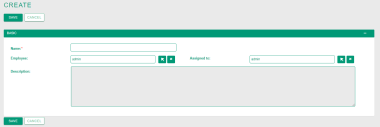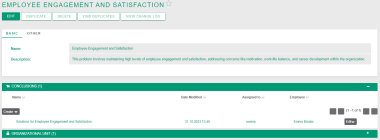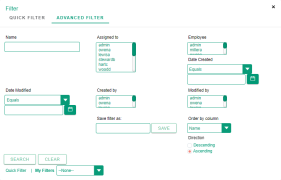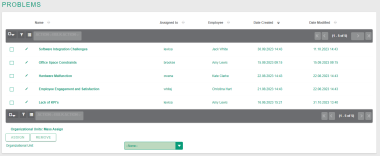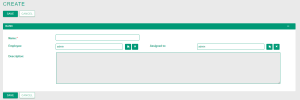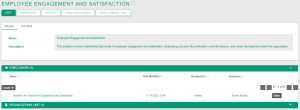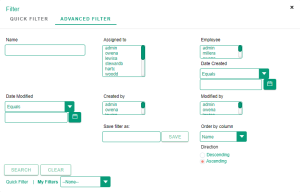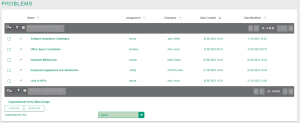Problems
| Problems | |
|---|---|
| Name: | Problems |
| Tech Name: | Problems |
| Class Name: | Problems |
| Type: | Standard |
| Template: | Security_groups, Assignable, Basic |
| Custom Module: | No |
| Auditable: | Yes |
| Importable: | No |
| Reportable: | Yes |
| Hide module on Main Page: | No |
Contents
Short Description
The Problems module is a tool for companies management. This module allows users to track and manage various issues, challenges, or concerns related to employees and their work. It is linked to the Employees module, facilitating seamless communication and problem resolution among team members.
Business Description
Overview
The Problems module is an tool for companies specializing in recruitment, payroll, and employee management. This module provides a centralized platform for tracking and managing various issues, challenges, or concerns that may arise within the workforce. It allows HR professionals and managers to efficiently categorize, prioritize, and address these problems, fostering a more organized and responsive approach to employee support.
One of the primary advantages of the Problems module is its close integration with the Employees module. This integration ensures that issues are directly linked to specific employees, enabling HR teams to monitor the impact of problems on individual workers and providing personalized solutions when needed. Furthermore, the module connects seamlessly with the Conclusions module, allowing businesses to analyze trends, identify recurring issues, and draw insights from resolved problems. This data-driven approach empowers companies to make informed decisions and implement proactive measures to prevent future challenges.
By utilizing the Problems module, businesses can enhance their overall HR processes, improve employee satisfaction, and strengthen their workforce management capabilities. It facilitates better communication, transparency, and accountability in addressing concerns, which, in turn, can lead to increased employee retention and a more productive work environment. In summary, the Problems module in MintHCM is a valuable asset for HR-focused companies, promoting efficiency, data-driven decision-making, and employee well-being.
Fields
The Problems module is comprised of multiple fields, each meticulously crafted with a distinct purpose in mind, serving to capture and organize essential Problems-related information. Here is a detailed explanation of each field:
| Name | The Name field is used for clear problem identification, allowing users to label and categorize issues for easy reference and prioritization. | |
| Description | In the Description field, users can provide comprehensive details about the problem, helping to ensure that all relevant information is documented for effective issue resolution. This field serves as a central repository for the issue's context, history, and any associated data. | |
| Employee | By specifying the affected employee in the Employee field, users can directly associate problems with the individuals they impact, making it easier to provide tailored support and solutions to personnel. | |
| Assigned to | The Assigned to field is used for designating responsibility for addressing the problem. This ensures that a designated team member or department takes charge of the issue, streamlining the resolution process. | |
| Date Created | The Date Created field records the timestamp of when the problem was initially documented. This chronological data provides a historical perspective on the issue's existence and evolution. | |
| Date Modified | The Date Modified field keeps track of any updates or changes made to the problem record. This information is essential for monitoring the progress of issue resolution and maintaining an accurate history of the problem's management. |
Note: Fields marked with an asterisk are required. Saving the record without providing input to them beforehand won't be possible.
Relations
The Problems module establishes relationships with several other modules within the system, allowing for seamless integration and efficient management of the recruitment process. These related modules include:
The relationship between the Problems module and its sub-module Conclusions is essential for issue resolution and decision-making within an organization. The Problems module serves as a repository for documenting and tracking various issues, challenges, or incidents that occur within the company. When a problem is identified, it is essential to work through a structured process to address and resolve it.
This is where the Conclusions sub-module comes into play. Conclusions is dedicated to capturing the outcomes of the investigations and efforts made to resolve the problems documented in the main module. It allows employees to provide a detailed account of the steps taken, the root causes identified, and the solutions implemented to mitigate or eliminate the issues.
The relationship between these modules is important for several reasons. First, it ensures that the resolution process is fluent and transparent, as it tracks the entire lifecycle of a problem, from its initial report to its final conclusion. This transparency is beneficial for accountability and performance improvement.
Additionally, the Problems and Conclusions modules connects directly to the Employees module. This integration allows for the association of employees who were involved in problem-solving efforts. It helps in recognizing the contributions of individuals or teams and provides a basis for performance evaluations or recognition.
Role in the Hiring Process
The Problems and Conclusions modules have a important role in the hiring process by evaluating candidates' problem-solving skills. These modules help assess how candidates have addressed and resolved issues in previous roles, providing insights into their analytical abilities. By integrating these modules into recruitment, organizations can make more informed hiring decisions, ensuring candidates possess the problem-solving skills necessary for their roles. This aligns with the goal of maintaining an effective issue resolution culture within the organization. Overall, these modules enhance candidate selection by prioritizing individuals with strong problem-solving capabilities.
Custom Actions
Processes
Related Processes
Related Process Steps
Related Features
Affected by
Initiating
Related Integrations
Structure
Fields
| Name | Type | Required | Validations | Visible | Editable |
|---|---|---|---|---|---|
| Assigned to | relate | No | Yes | Yes | |
| Created by | relate | No | Yes | No | |
| Date Created | datetime | No | Yes | No | |
| Date Modified | datetime | No | Yes | No | |
| Description | text | No | Yes | Yes | |
| Modified by Name | relate | No | Yes | No | |
| Name | name | Yes | Yes | Yes |
Relationships
| Laft | Type | Right | Short Description | Relationship |
|---|---|---|---|---|
| Users | one-to-many | Problems | Specific Sugar user can modify many account records, but specific account record last modification was performed by specific user. | Relationship: Users - Problems |
| Users | one-to-many | Problems | Specific Sugar user can create many account records, but specific account record can be created by only one user. | Relationship: Users - Problems |
| Users | one-to-many | Problems | Specific Sugar user can be assigned to many account records, but specific account record can only have one user assigned. | Relationship: Users - Problems |
